|
July 10, 2020
Dear Neighbors and Friends:
I hope that you and your loved ones are doing well, staying healthy, and looking out for your neighbors and friends.
Today’s newsletter includes today’s COVID metrics (case counts and deaths down a little, hospitalization up a little), troubling information from OHA regarding likely projections if we stay on the current course, and more information about the likely causes of growing transmission.
In addition, you’ll see the preliminary agenda for next week’s Legislative Emergency Board meeting, scheduled for Tuesday morning.

TODAY’S CORONAVIRUS AND CORONAVIRUS RESPONSE UPDATE
-
Positive Cases: OHA has reported that an additional 249 people have tested positive. The cumulative total for those testing positive is now 10,881.
-
Total Tests: OHA reports an additional 4,678 total tests. The cumulative total since the beginning of the pandemic is now 286,197.
-
Ratio: The percentage of positive tests results for today is 5.3%. You can see Oregon’s ratio for the last two weeks in a graph below. The national percentage today is 8.1%.
-
Deaths: I regret to report 2 additional deaths due to the coronavirus. The total number of deaths in Oregon is now 232.
-
Hospitalized: OHA has reported 18 additional hospitalizations due to COVID. The cumulative number of those who have been hospitalized with COVID is now 1,180
-
Presumptive Cases: OHA is now including “presumptive COVID-19 cases” in its daily reports, consistent with recently amended guidance from the Centers for Disease Control and Prevention. A presumptive case is someone who does not yet have a positive PCR test result but is showing symptoms and has had close contact with a confirmed case. If they later test positive by PCR, those will be recategorized as confirmed cases. OHA reports 26 new presumed positives today. The total number of presumed positives is now 573.
-
Other Hospital Information:
- Patients Currently w COVID-19 Symptoms (who may or may not have received a positive test result yet): 208 (16 more than yesterday). Of those, 139 have already received a positive test back.
- Available ICU Beds: 117 (8 fewer than yesterday).
- Other Available Beds: 680 (18 fewer than yesterday).
- ICU Patients w COVID-19 Symptoms: 56 (3 fewer than yesterday).
- COVID-19 Patients Currently on Ventilators: 30 (5 more than yesterday).
- Available Ventilators: 776 (11 fewer than yesterday).
-
Dashboards
-
Today’s National Numbers:
-
PPE:
-
Additional Brief Items:
- As promised, the Oregon Employment Department has revamped their website to make it more user-friendly. Take a look.
Modeling Shows Danger If We Continue at Current Pace
OHA Director Pat Allen and State Epidemiologist Dean Sidlinger shared information from this week's modeling update, Now that last week’s record numbers have been included in the analysis, we can see the full effects of reopening playing themselves out.
OHA estimates that for every positive test result, there are an additional seven undiagnosed cases out there. In other words, with 249 positive test results today, the actual number of new infections today is likely 1,743. This has the ability to create “exponential” growth in the disease by the end of the month. Even if the hospitalization rate remains low, because the spread is mainly around younger people, with numbers this high we will inevitably see many more people being hospitalized, putting pressure on our system. We will inevitably see spread to older, more vulnerable individuals, resulting in more deaths and more stress on ICUs.
According to the modeling, a mere 10% increase in new infections could result in hospitalization rates for severe cases surging from 17 a day last week (today is 18) up to 76 a day by the end of the month. We’ve already seen an increase of 25% since the middle of May, when the reopening process began in Oregon.
Dr. Sidelinger said that he thinks we can handle the current rate of increase in hospitalizations for the next two months. If the rate increase, that period will shorten.
So What’s the Cause?
As I mentioned a few days ago, aside from the workplace outbreaks, it’s social gatherings appear to be the main source of the spread. This was what legislators were told in a briefing by the OHA. Today, the OHA issued more information about that in its daily press release. Here’s what they had to say:
Social gatherings are increasing spread.
Since Oregon began reopening, we have seen spread of COVID-19 when people get together to celebrate with family and friends. Some examples include:
- Graduations
- Birthdays
- Weddings
- Holidays
COVID-19 is spreading more among social activities involving groups of younger people. OHA has recorded outbreaks linked to:
- Exercise classes
- Fraternity party
- Bachelor party
While it is difficult not to celebrate these events as we have in the past, COVID-19 is spreading in our communities and people must think hard about altering daily routines that may put people at risk.
OHA recommends that everyone:
- Limit the size of our gatherings
- Keep our distance
- Cover our faces
- Find alternative ways for those who are vulnerable to participate.
The only specific example of social spread given by Director Allen was a baseball team’s trip from Yamhill County to Douglas County, a trip which resulted in 20 positive cases.
The modeling does suggest that there are multiple scenarios for how the disease will play out in the coming months, and to a large degree we can influence the direction it takes. That’s why OHA is urging Oregonians to again limit the size of their social gatherings to 10 or fewer. This is not yet a formal requirement, but Oregonians are being asked to be aware, self-monitor, and keep the numbers from growing.
Although it’s too early to tell, preliminary studies indicate that the broader wearing of face coverings can also limit the increase in cases.
On another note, Director Allen today again pointed out the growing national shortage of testing materials, which is becoming another problem for us here in Oregon. It’s more of a problem, ironically, because we’re still considered a (relatively) low-incidence state. The states with the huge daily increases in the thousands are being given priority. You’ll see above that national testing numbers are reaching record levels, which is great, but the U.S. has still not fixed its supply-chain problems. To a large extent in our broken federal system, it’s again every state (and often local government and hospital chain) for itself.
Where Are Today’s New Cases?
If we put together the positive test results and new “presumptive” cases reported today, the overall number of new cases is 275. Two-thirds are from outside the Portland Tri-County region. Here is the breakdown by county for today:
Baker (1)
Benton (6)
Clackamas (11)
Crook (1)
Deschutes (8)
Douglas (2)
Hood River (4)
Jackson (9)
Jefferson (15)
Josephine (2)
Lane (10)
Lincoln (15)
Linn (3)
Malheur (21)
Marion (28)
Morrow (3)
Multnomah (37)
Polk (3)
Tillamook (1)
Umatilla (51)
Union (1)
Wallowa (1)
Wasco (5)
Washington (44)
Yamhill (8)
And the Deaths
Oregon’s 231st COVID-19 death is a 62-year-old man in Union County who tested positive on June 16 and died on July 2, at Saint Regional Medical Center in Boise.
Oregon’s 232nd COVID-19 death is a 99-year-old woman in Lincoln County who tested positive on June 26 and died on July 9. Location of death is being confirmed.
E-Board Set to Meet Tuesday Morning
The Legislature’s Emergency Board, which makes allocations when the full Legislature is not in session, will be meeting Tuesday morning at 10. You can follow its work on the legislative website.
Here’s what’s listed on the agenda at this point. I believe that they all will be using federal dollars from the CARES Act:
- COVID-19 Emergency Business Assistance
- Statewide Business and Cultural Support
- Oregon Cares Fund for Black Relief and Resiliency
- COVID-19 Leave Fund for Quarantined Workers
- Emergency Relief Checks (This is the $500 that will be sent to those on hold for their Unemployment and Pandemic Unemployment benefits.)
- Election Security
Intrigued? So am I. We don’t yet have details about these allocations, either how exactly they will be used or how much will go into each, though I expect that this will become clearer in the next few days. The webpage will be updated with information under Meeting Materials that will reflect that actual proposals, so keep checking back.
As the agenda indicates, there will also be a presentation reporting on the aid that we’ve given to rural hospitals.
Additional Graphs:
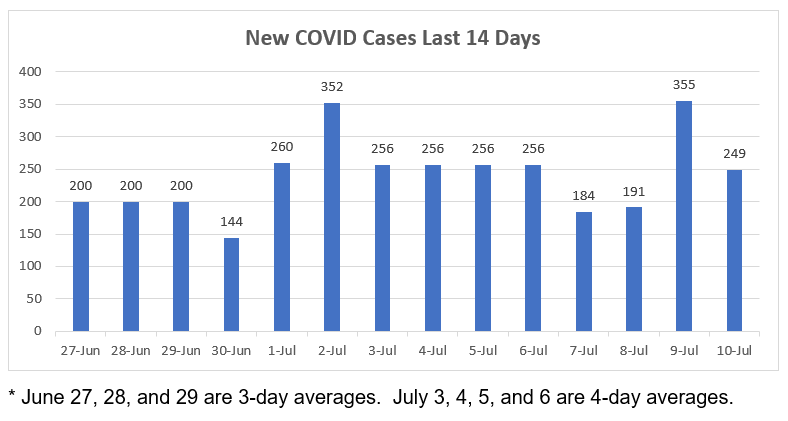
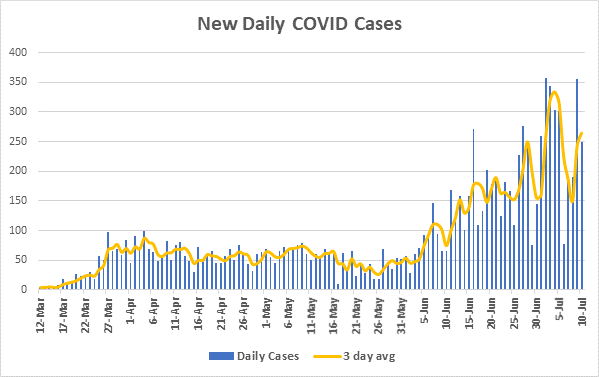
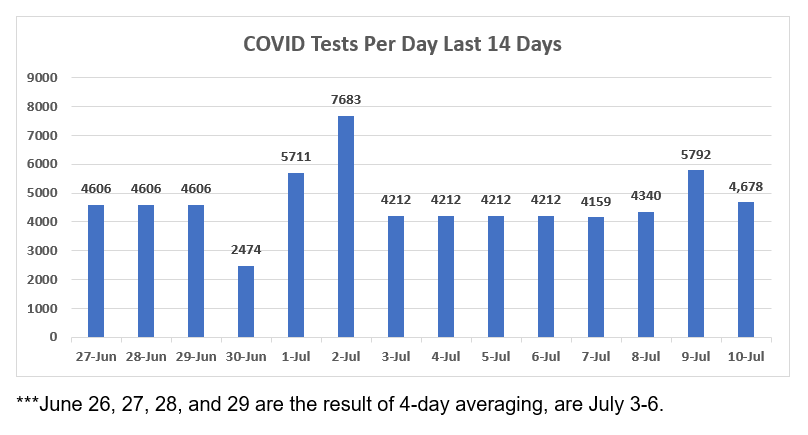
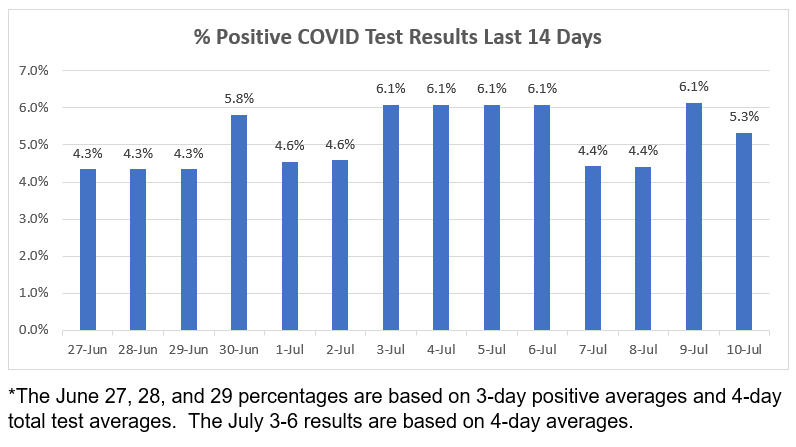



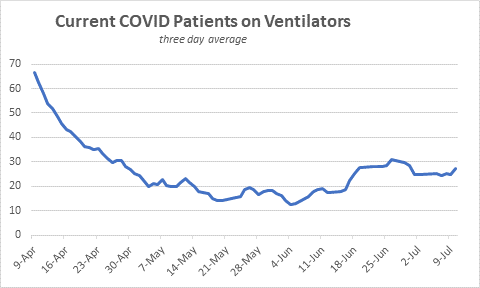
Want to See Past Newsletters?
If there was COVID-related information in a past newsletter that you want to go back to, but find you’ve deleted it, you can always go to my legislative website (www.senatordembrow.com), click on “News and Information,” and you’ll find them all there. Also, if someone forwarded you this newsletter and you’d like to get it directly, you can sign up for it there.
AND FINALLY,
Here again are some resources that you will find useful:
If the above links are not providing you with answers to your questions or directing you to the help that you need, please consider me and my office to be a resource. We’ll do our best to assist you or steer you in the right direction.
Best,
 Senator Michael Dembrow
District 23
email: Sen.MichaelDembrow@oregonlegislature.gov
web: www.senatordembrow.com
phone: 503-986-1723
mail: 900 Court St NE, S-407, Salem, OR, 97301
|